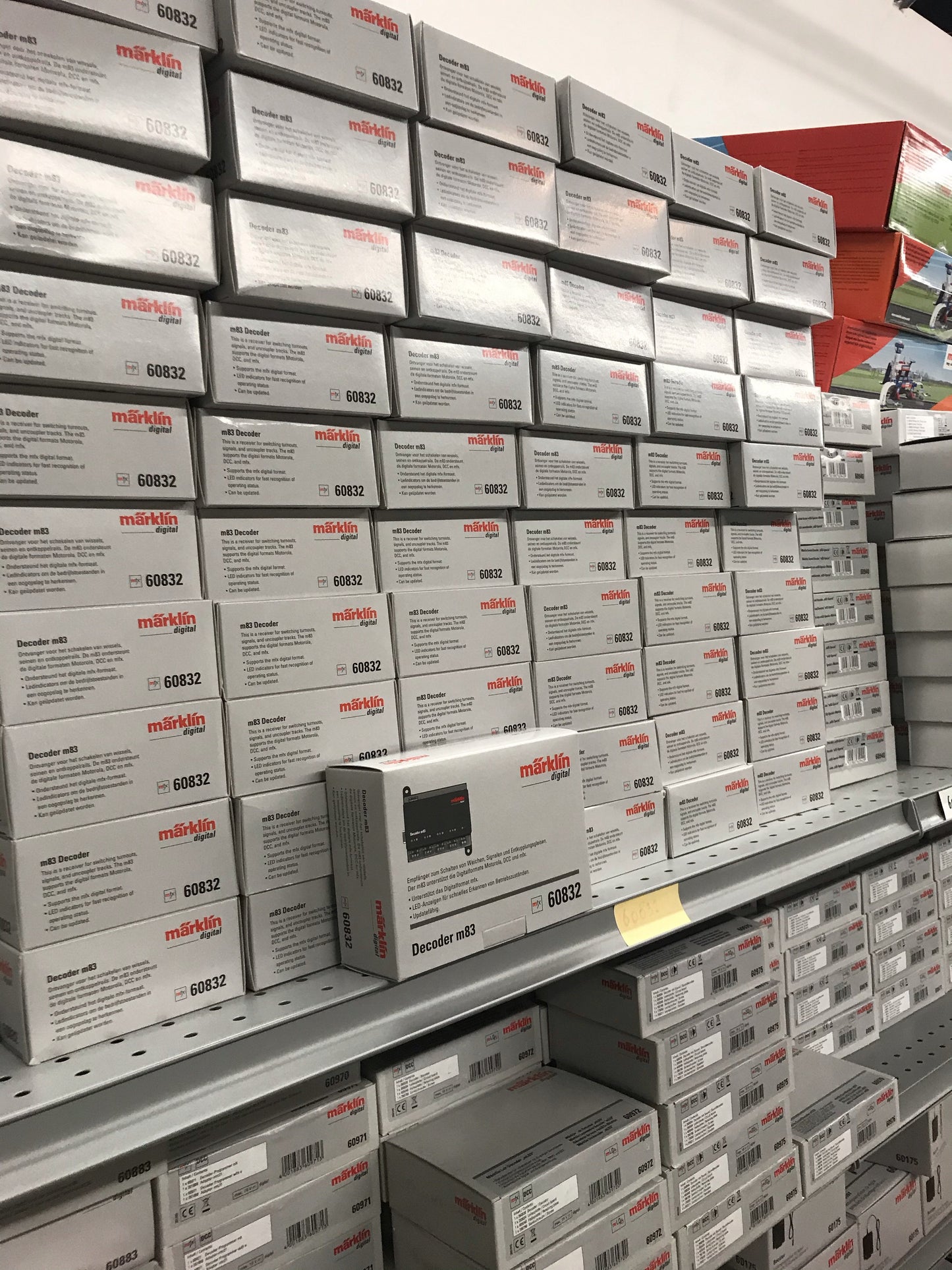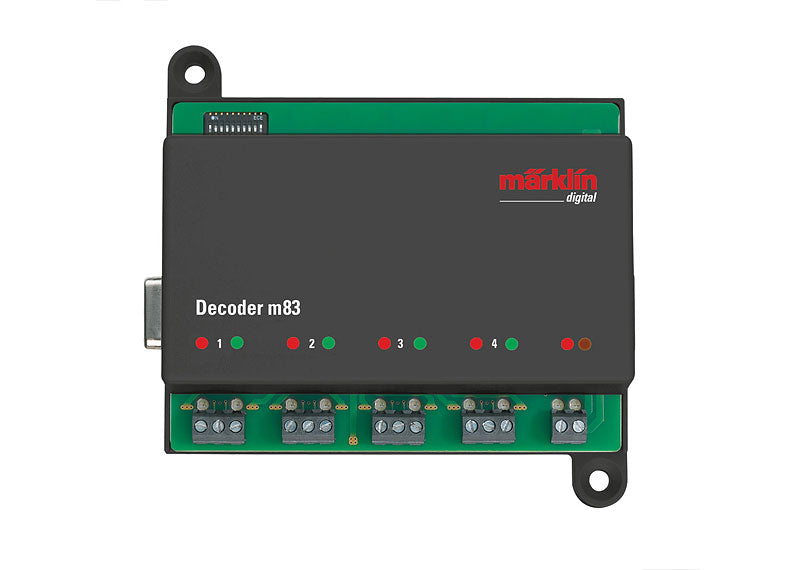Marklin 60832 - M83 switch/turnout Decoder (black)
m83 Decoder
This is a receiver for switching turnouts, signals, and uncoupler tracks. The m83 supports the digital formats Motorola, DCC, and mfx. The digital address can be set by means of coding switches or by means of the programming track in 4 steps. The address range in the Motorola format is up to 320 and in the DCC format up to 2040. The m83 has 8 outputs that can be controlled separately or in pairs. These outputs are preset for switching up to 4 turnouts. Examples of other functions are switching up to 8 lighting circuits (dimmable) with a defined power-on behavior (example: street lighting, house lighting).
External power supply is possible, but not needed. The M83 can use just your track power. If you want a separate power supply, for example: by means of 66367 wall plug in transformers, you have to buy a Marklin 60822.
The m83 and m84 decoders can be arranged in any sequence. The connect to each other and share the external power.
A Marklin 60821 accessory set is required per pair of outputs for motor drives. Connections on the decoders are done by means of set-screw terminal clips. The maximum current load is 3 amps.
Operation with MM (Motorola):
Dip switch 10 must be set at “OFF“ for operation of the m83 with MM. The turnouts connected to the m83 can now be addressed and activated with the addresses previously set. The monitor lights on the decoder will display the switched status of the turnouts (green / red).
Advanced Functions
Programming can be used to set additional functions on the m83 turnout decoder. These programming parameters must be done at the programming track. Different parameters can be set using address 80. The two corresponding monitor lights will blink as a check feature during the data transfer. The turnout to be programmed must be switched with the Keyboard before the programming. After that, change the parameters immediately with the Control Unit or with the CV configuration on the Central Station. After you have completed the programming process, immediately switch the programmed turnout again with the Keyboard. The programming has not been accepted and is not effective until now.
The procedure for programming with the 6021 Control Unit is analogous to the programming for locomotives (www.maerklin.de -> Tools & Downloads -> Technische Informationen).
The function “Automatic Turnout Circuit“ can be used to link 2 outputs on the decoder together and switch them together for a three-way turnout or a double slip switch.
Additional settings are possible with DCC, and these settings also influence operation with MM.
The 60821 control electronic circuit is also required for control of a motor.
Operation with mfx
Mfx registration can be done with MM or DCC.
The mode of operation that has been set by means of Dip Switch 10 is critical.
The mfx registration is initiated with the 60216/60226 CS3 in the solenoid item configuration by means of >“search for mfx item“.
Note about mfx registration with the CS2: Selection possibility „Automatically assign solenoid item“ at „Setup“ > > „Track“. If the check mark there is checked, the mfx registration is done at the first open address in the CS2. If the check mark is not checked, the mfx registration is done at the address actually programmed on the decoder.
CV 79 – Preset Operating Mode
With the preset operating modes, it is possible to move the decoder into a pre-defined operating mode without having to program all of the CV variables individually. The decoder then operates as building lighting, street lighting, etc.
Mode 0 (Value 0) – Standard Mode
In this mode of operation, the decoder occupies 4 addresses. This is the mode as delivered from the factory. It is used to control 4 solenoid mechanisms with an end shutoff feature.
Mode 1 (Value 1) – 8 Switches, 4 Addresses
In this mode of operation, the decoder occupies 4 addresses. Switching the outputs is done by means of momentary buttons (same button for on and off). An output is controlled by the red momentary button, and the green momentary button controls the second output.
Mode 2 (Value 2) – 8 Switches, 8 Addresses
In this mode of operation, the decoder occupies 8 addresses. Switching the outputs is done by means of red/green buttons. Red switches the output off and green switches the output on. The brightness of the output can be set by the parameter dimmer. The period has no function.
Mode 3 (Value 3) – Blinking and Random, 8 Addresses
In this mode of operation, the decoder occupies 8 addresses. Switching the outputs is done by means of a red/green button. Red switches the output off and green switches the output on. The decoder executes various blinking functions to simulate flickering lights or warning lights.
Mode 4 (Value 4) – Neon Street Lighting, 8 Addresses
In this mode of operation, the decoder occupies 8 addresses. Switching the outputs is done by means of a red/green button. Red switches the output off and green switches the output on. This mode simulates the starting of neon tube lights. The brightness of the output can be set by the parameter dimmer. The period determines how long the flickering of the light tubes coming on lasts.
Mode 5 (Value 5) – Energy Saving Lighting, 8 Addresses
In this mode of operation, the decoder occupies 8 addresses. Switching the outputs is done by means of a red/green button. Red switches the output off and green switches the output on. This mode simulates the starting of energy-saving lights or pressurized gas lamps. The brightness of the output can be set by the parameter dimmer. The period determines how long the fading in of the lights lasts.
Operation with DCC
Dip switch 10 must be set at “ON“ for operation of the m83 with DCC. The turnouts connected to the m83 can now be addressed and activated with the addresses previously set. The monitor lights on the decoder will display the switched status of the turnouts (green / red).
Advanced Functions
Programming can be used to set additional functions on the m83 turnout decoder. Most CVs can be set “in operation“ (POM). The address on which the first turnout is set for the decoder to be programmed must be called up in order to program the CVs. If the address itself is to be changed by means of programming, then the turnout decoder must be connected to the programming track and dip switches 1 to 9 set to “OFF“ – the decoder can then be programmed by means of the address previously set or programmed.
In addition to general settings for the decoder, it is also possible to do settings at individual decoder outputs. Possible switching functions of this kind can be found in the separate table on page 25. The 60821 control electronic circuit is also required for control of a motor.
EAN/UPC: 4001883608327







